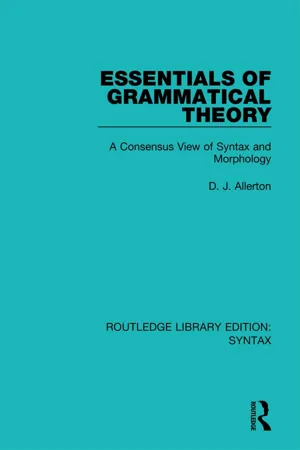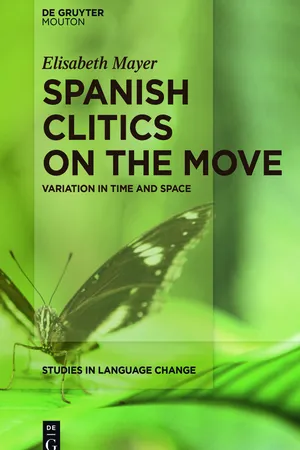Languages & Linguistics
Objective Case
The objective case is a grammatical case used for the direct object of a verb or the object of a preposition in a sentence. In English, pronouns such as "me," "him," and "her" are in the objective case when they function as direct objects or objects of prepositions. In other languages, nouns and pronouns may also change form to indicate the objective case.
Written by Perlego with AI-assistance
Related key terms
4 Key excerpts on "Objective Case"
- eBook - ePub
Essentials of Grammatical Theory
A Consensus View of Syntax and Morphology
- D. J. Allerton(Author)
- 2016(Publication Date)
- Routledge(Publisher)
kirja, ‘book’), Turkish, various Amerindian languages, etc.; it might be regarded as a variant of the category of person.The category of case is usually thought of as a category of the noun or noun phrase, but, although it is invariably a nominal inflection, the choice of case is determined outside the noun phrase. There is a less obvious semantic link than with number, gender or person. The case of a noun phrase serves to indicate its syntactic function in the sentence, in particular its connection with a verb or preposition.The number of cases distinguished in languages can be anything from two (as in Swedish) up to as many as fourteen (as in Finnish) or more. The sentential functions pivoting on the verb include subject, direct and indirect object, and predicative complement; each function has its characteristic semantic value but this is shaped by the character of the particular verb associated with it (– as is also the number of such noun-phrase functions required in a particular sentence. While sneeze requires only a subject, give requires subject, direct object and indirect object). Thus defeat has ‘the vanquished’ as object, while lose has this role as subject. Languages typically have a basic or nominative case, often with zero affix, that occurs in subject position, at least for intransitive verbs, but there may be a separate ergative case, as in Basque or Eskimo, for causative verbs like ‘(cause to) break’. The direct object may be given the nominative case as in Rumanian or the genitive as in Finnish (but nominative in the plural!), but commonly a separate case form, the accusative, is used. Nevertheless, even where an accusative case does exist, particular verbs may select other cases for their objects such as dative (German), ablative (Latin). Where a dative case exists, it is used for the indirect object. The predicative complement (as in English (He was) a Frenchman/teacher - eBook - ePub
- Elisabeth Mayer(Author)
- 2017(Publication Date)
- De Gruyter Mouton(Publisher)
Case is a complex phenomenon in terms of meaning, morhphological form and their relationship with grammatical relations. The latter can be expressed in different ways, some languages use word order to overtly mark the position of specific clause or sentence elements, others use nominal and verbal morphology to encode grammatical relations allowing for varying freedom of word order. For example, whereas structural case is used to identify syntactic relations (e.g. subject, object, indirect object, etc.), semantic case encodes semantic relations in terms of agency, animacy, definiteness, specificity, affectedness among other properties. Other functions of case are to mark telicity or boundedness in the tense/aspect system in the verbal domain (Kiparsky 1998; Ritter and Rosen 2001), and to interact with discourse functions such as topic and focus (Aissen 2003; Dalrymple and Nikolaeva 2011). The latter applies to differential object marking in Spanish, especially to the variability in clitic doubling constructions across dialects. In sum, the multiple ways languages code their grammatical relations gives rise to different types of case marking systems dependent on their grammatical alignment and word order type.Casemarking in Romance languages is based on Latin which, as shown in example (48), exhibits gender and case in nominal inflectional morphology in terms of declension classes and relatively free order.Spanish is a nominative-accusative language with minimal case marking; the nominative/accusative case system is only marked on personal pronouns and on some relative pronouns. As shown in example (49), the nominative subjects show agreement morphology on the verb, nominative case is unmarked and noun phrases show gender and number agreement. Objective and genitive case are marked by the prepositions a (49a) and de (49b), respectively, with (49a) as a case of differential object marking.Spanish uses a mix of configurational and morphological means to identify grammatical relations, and employs two different strategies to mark the object function: (i) clitics as a deictic strategy to mark agreement, and (ii) morphological case to mark a relational strategy (Croft 1988: 173). As pointed out by Nichols (1986), case and agreement are two parallel strategies to mark essentially the same head-dependent relationship. For Spanish, coocurrence of head- and dependent marking is obligatory with dative arguments including the gustar (‘like’) experiencer construction in (50) which shows dependent-marking by morphological case a and head-marking by the dative clitic le - eBook - ePub
Word and Its Ways in English
Essays on the Parts of Speech and Person
- Walter Hirtle(Author)
- 2017(Publication Date)
- McGill-Queen's University Press(Publisher)
Case as a Grammatical Category in Modern English INTRODUCTIONThere are many approaches to case on a theoretical level. Blake, for example, defines case as “a system of marking dependent nouns for the type of relationship they bear to their heads,” a definition considered too restrictive by Butt.1In her study involving “a comparative look at case across syntactic theories,” Butt considers case “a handy tool for marking semantic relationships between nouns and verbs, or more generally between dependents and a head,” a view that may also be too restrictive, as we shall see. Most of the “primarily syntactically oriented” approaches she examines are concerned with “crosslinguistic factors.”2According to Schlesinger, “the current conception of cases rests on the implicit assumption that it is possible to categorize relations that are ‘out there’ … there have been proposals comprising as few as three … up to an estimated forty to fifty categories.”3 Here, our concern will be limited to Modern English.Most grammars of English discuss case in the context of the personal pronouns and the nominal -’s , which is generally dubbed the “genitive case,” as opposed to the “common” case of the substantive. They take for granted the subject and object roles of noun phrases in English, and the fact that in the sentence these functions are usually expressed by position in relation to the verb. Some grammars mention in passing noun phrases as adverbials, as in He went that way , and “nouns used as attributive modifiers” as in noun phrase , but to my knowledge none show how the same grammatical category of the substantive’s “common” case can give rise to such varied syntactic roles for the noun phrase.4 - eBook - ePub
- Diane C. Nelson(Author)
- 2013(Publication Date)
- Routledge(Publisher)
Chapter 2 Grammatical Case Assignment in Finnish 2.1 IntroductionPatterns of Objective Case in Finnish, or, more precisely, case marking on internal arguments and quasi-arguments, are problematic for Case Theory for a number of reasons and so have attracted scrutiny in the previous literature on Finnish. In simple transitives, subjects appear in nominative case and objects in accusative (identical in form to singular genitive case in full DPs) or partitive case. However, despite predictions made by Case Theory and Burzio’s Generalization, full DP ‘nominative objects’ (here referred to as ‘zero accusatives’) surface in certain well-defined syntactic contexts, but alternate with accusative-marked animate pronouns in the same environments. Moreover, the distribution of both of these accusative forms alternates freely with partitive case. A separate form for plurals also exists, which is identical for nominative and accusative cases.Data is presented first illustrating nominative and Objective Case marking in transitive sentences. Next, the partitive/accusative alternation is examined. Finally, data illustrating the theoretically problematic zero-accusative case form is discussed, followed by a review of the previous literature on the topic.2.2 Subject and Object CaseCanonical subjects appear in nominative, morphologically unmarked, case and agree with the verb. Plural nominative case is signalled by a suffix, -t:1Nominative pronouns occur within the following paradigm:Objective Case in simple transitive sentences may be marked with one of three suffix forms, accusative -n and -t, and partitive -TA. The distribution of the -n
Index pages curate the most relevant extracts from our library of academic textbooks. They’ve been created using an in-house natural language model (NLM), each adding context and meaning to key research topics.



